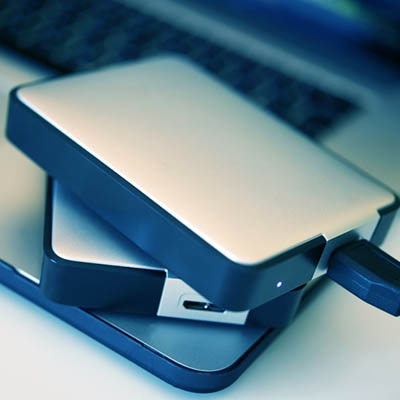How do you handle on-premise, physical data backups? This is a question that you don’t want to be asking during a crisis. Despite many benefits of digital storage, physical data backup is still an important part of the business continuity process. A physical backup could save your business from total loss.
First, when we mean physical backup, we refer to data backup that is run and stored at your location, as opposed to only having your backup in the cloud. Unless your data is already in the cloud, you need to keep a physical backup of your files on site.
Types of Physical Data Backup
Your business probably already uses several kinds of physical data backup devices; USB hard drives, thumb or flash drives, network attached storage (NAS), and tape-based backups. These are all useful for different reasons.
Portable Drives
A thumb drive makes information wonderfully portable, and a hard disk drive or solid-state drive stores large amounts of data for portable use. Yes, these devices are cheap and convenient, but you NEVER want to rely on a consumer-based storage solution like a USB drive to be the only backup you have. The portability of thumb drives and portable drives makes them vulnerable to get lost, stolen, or damaged.
Tapes are Old School
Tape-based backups are a different story. They are meant to be used in backup systems that store data on magnetic tape and restore them in the event of an emergency. It’s best to store your tape backups off-site, in case something happens to your building. Tape backups are comparatively clunky, so hybrid solutions that store your data on disk while archiving it to the cloud have taken over the business continuity field. This provides the redundancy of having both cloud backup and local physical backup.
How to Effectively Use Your Physical Backup
The most important part of using physical data backup is keeping it safe. You need to make sure it’s safe in the event of a disaster, and safe on a daily basis. Physical backups need at least as much maintenance, monitoring, and cybersecurity as the rest of your network. Build a physical backup protocol that can come into play in the event of a disaster scenario.
The 3-2-1 rule is helpful to ensure seamless business continuity. You should always have three copies of your data; one stored off-site or in the cloud just in case, one stored on-site for easy access, and the original that you use.
Why Have Local Physical Backup?
If your data is safely backed up in the cloud, why do you need to put so much care into ensuring that it is also backed up at your location? Redundancy is peace of mind. Cloud solutions promise redundancy and nearly constant uptime, but they’re not infallible. Keeping a copy of your backup on a local device can’t hurt in the event of a catastrophic data-loss event. It’s also more convenient to restore a single file or directory from a local backup than spinning up the data from the cloud.
Need data backup or disaster recovery? Quikteks can help. Reach out to us at (973) 882-4644.

